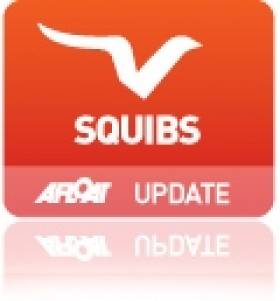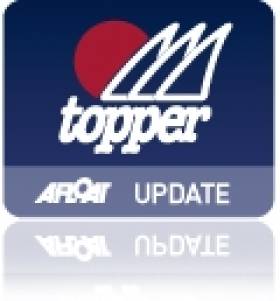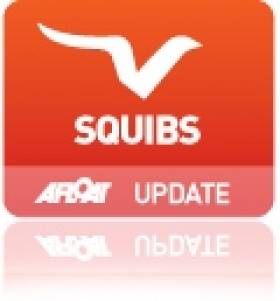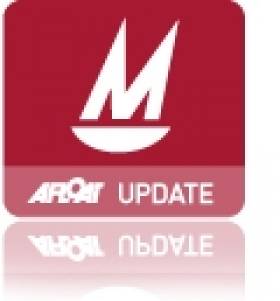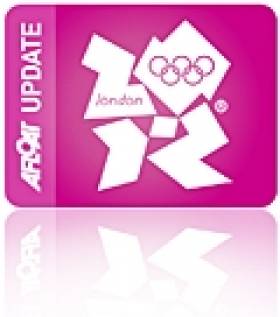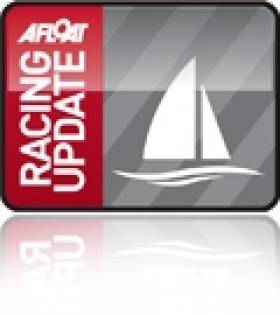Displaying items by tag: Royal North of Ireland Yacht Club
#squib – In August, the Squib Class will be returning to the southern shores of Belfast Lough and the Royal North of Ireland Yacht Club.
The Rodgers & Browne Squib Irish Championship, supported by North Down Borough Council, will be held over the 9th- 11th August and will attract Squibs from throughout Ireland to compete for the national trophy.
The Squib Class is one of the largest one design keelboat classes in Ireland. It is sailed by two people and is well known for its distinctive brown sails. Over the last decade fleets have flourished at Killyleagh Yacht Club, Quoile Yacht Club, Royal St George Yacht Club (Dublin) and Kinsale Yacht Club, in addition to the traditional strongholds of Cultra and Howth Yacht Club.
The reigning champion pairing of James and Bruce Matthews from Kinsale Yacht Club will battle with past winners and recently crowned Eastern Champions, John Driscoll/David Cagney, and Northern Champions, David Eccles/Michael Wright, all of whom are in contention for the main prize.
Thomas Anderson, Commodore of the Royal North commented "I am delighted to welcome the Squib Irish Championship back to Cultra. This has only been possible with the ongoing support of Rodgers & Browne and North Down Borough Council. The Squib Class has been the backbone of our Club for several decades and it is fantastic that the fleet will be showcased through this event. In addition to the excellent sailing waters of Belfast
Lough, the Club's well known hospitality will ensure that this event will be well worth attending".
Connor Browne, Partner at Rodgers & Browne, said "We are looking forward to collaborating again with the Royal North of Ireland Yacht Club and the Squib Class to bring the Irish Championship to Cultra. North Down is a stunning location for many sporting activities, which is reflected in the demand for housing within the greater Holywood, Helen's Bay and North Down areas."
Quinn Out Sails 70 Toppers At RNIYC for Northern Honours
#topper – Carlingford's Conor Quinn has added the Northern Topper title to the Eastern title he won in May. The Louth single–hander outsailed 70 Toppers at Royal North of Ireland Yacht Club for the Ulster Championships 2014. Day one of the two day event saw the wind slowly filling in by 12 noon, allowing a very impressive fleet of Topper sailors to launch from the shores of Belfast Lough. By 3pm there was a perfect northerly breeze of twelve knots permitting the OD to complete three races. Full results below.
#squib – The Squib keelboat class will be returning to the southern shores of Belfast Lough and the Royal North of Ireland Yacht Club this weekend.
The Rodgers & Browne sponsored Squib Northern Championship will attract Squibs from across Ireland to compete for the coveted trophy.
The Squib Class is one of the largest one design keelboat classes in Ireland. It is sailed by two people and is well known for its distinctive brown sails. Over the last decade fleets have flourished at Killyleagh Yacht Club, Quoile Yacht Club, Royal St George Yacht Club and Kinsale Yacht Club, in addition to the traditional strongholds of Howth Yacht Club and Cultra.
The reigning champion pairing of Davy Eccles/Phil Hutchinson on Inshallah, from the host club, will again have to mount a strong defence if they are to retain the trophy for a second year. Likely contenders include previous champions, Gordon Patterson/Ross Nolan on Quickstep III and Sam Lyness/Eric Heyes on The Worm, who have both been showing promising form of late.
However, it would be foolish to dismiss the presence of previous Irish National pairing Greg Bell/Leah Anderson on Prodigal and Jonathan Craig/Hazel Ruane on Kerfuffle.
Wendy McCullough, Commodore of Royal North commented, "I am delighted to welcome the Squib Northern Championship back to Cultra and our new partnership with Rodgers & Brown. The Squib Class has been the backbone of our Club for several decades and it is fantastic that the fleet will be showcased through this event. In addition to the excellent sailing waters of Belfast Lough, the Club's well known hospitality will ensure that this event will be well worth attending."
Kearney and Odell Add World Mirror Title
After a solid performance in testing conditions Ross Kearney and Max Odell have won the Mirror World Championships in Albany, Australia today. The Royal North of Ireland pair finished the series with two good races on the final day to lead the 61-boat fleet after 15 races sailed.
For the final rounds the winds blew 18-22 with gusts to 28 knots for both races - Kearney had a third in the first race this morning, followed by another third and then a second to clinch the series.
The results is so far provisional and subject to confirmation. Overall score sheet available for download below.
Last August, in Sligo, the Belfast Lough duo picked up the European title.
The prizegiving ceremony is underway in Albany now at 8pm Australian time and there will be more updates later on the win for Ireland.
It is not the first time Royal North of Ireland Yacht Club is celebrating a world championship homecoming tonight because Kearney won it previously in Sweden in 2005 aged 19. He was crewed then by Adam McCullough (11) when they lifted the world title at Östersund.
Today is Ireland's fifth win of the regatta that is open to all but is predominantly contested by youth crews.
The Belfast youth's follow in the footsteps of club mates Chris Clayton and Craig Martin who won the championship in Australia in 2003 previous to that Ireland won the biennial fixture in South Africa in 1999 and also when it was hosted in Howth in 2001.

Ross Kearney and Max Odell survive a luff in 20 plus knots ! Photo: Rob Cruse. More photos from Rob HERE.
Kearney named January Sailor of the Month HERE
Belfast Olympic Hope Presents £18,000 Boat to Charity
Twenty-year old sailor Tiffany Brien from Royal North of Ireland Yacht Club presented an £18,000 Paralympic sailing boat to local disabled charity Belfast Lough Sailability in Belfast Harbour today – the culmination of two years of fundraising by the 2012 Olympic hopeful.
The boat was officially launched today at Abercorn Basin, Titanic Quarter Belfast and was formally named 'Will Power' by Tiffany and Len O'Hagan, Chairman of Belfast Harbour. The significance of the name relates to a very close friend of Tiffany's, Will Doggart, who was paralysed last year following an accident. Will attended the launch today and has sailed in the new boat alongside Tiffany.
The 'Skud 18' sailing boat took two years to build in Australia and is the most high tech paralympic boat available. 'Will Power' is the first of its kind to arrive in Ireland and has already been committed to the goal of qualifying for the Irish Paralympic sailing team for the 2012 Paralympic Games - with local athlete Steve Frecknell hoping to compete for a medal. The boat will be the responsibility of Carrick based sailing charity Belfast Lough Sailability who will also use the boat to help disabled sailors to sail competitively in Northern Ireland.
Tiffany Brien began her fundraising campaign two years ago when she sailed 30 miles single-handedly across the Irish Sea from Portpatrick in Scotland to Belfast Lough raising a total of £18,400. Before launching the boat today she commented: "I am so excited to be sailing the new boat in Belfast Harbour today. It feels like I have been waiting for a long time for it to arrive. It is even more exciting that the Irish Paralympic sailing team has committed to using the new boat in their campaign for the 2012 Paralympic Games - fingers crossed it helps to bring a medal back."
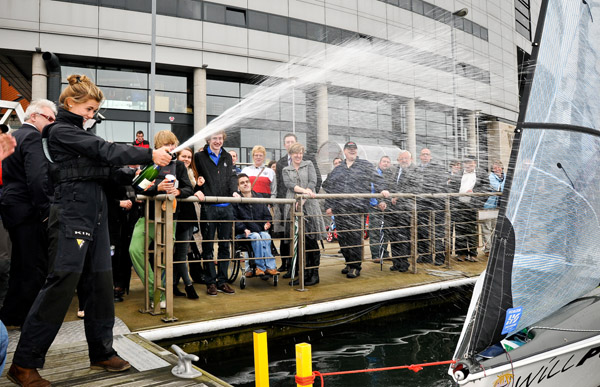
Tiffany will also be hoping to bring an Olympic medal back to Northern Ireland as she is currently competing to represent Ireland in the Laser Radial Class at the 2012 Olympic Games.
Nigel Thompson, Chairman of Belfast Lough Sailability comments: "Everyone at Sailability is totally overcome with the sheer determination and generosity Tiffany has shown in her fundraising campaign. The arrival of the boat today is the culmination of the dedication and resolve demonstrated by this young lady when she sailed singled handedly across the Irish Sea. Not only will our Paralympic hopefuls benefit from this but many other disabled sailors in Northern Ireland will get to enjoy this exceptional boat - including Tiffany's friend Will, who hopes to become an active member of Sailability and a keen sailor. We would like to thank Tiffany sincerely and wish her the best of luck in her own Olympic campaign."
Belfast Lough Sailability is a "not for profit", volunteer-based charity which, through the activity of sailing, enriches the lives of people with any type of disability, the elderly, the financially and socially disadvantaged.
Belfast Harbour has been the principal sponsor of Tiffany's Sailability campaign. BTWCairns, Airtricity, Stena Line, Belfast Telegraph and Ulster Bank and Brook House Art & Design are associate sponsors.
Byrne is National Dragon Champion
It was a one-two-three for Royal St George Dragon sailors at the 2010 Irish Dragon Championship, sponsored by Belfast Harbour, North Down Borough Council and hosted by Royal North of Ireland Yacht Club.
Club vice-commodore Martin Byrne took the title, five points clear of Don O'Donoghue.
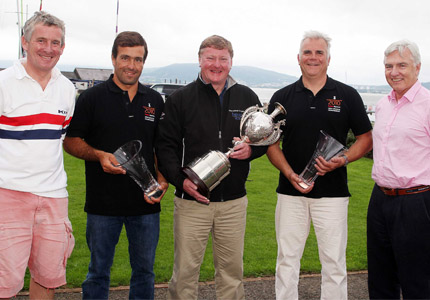
Royal St George Dun Laoghaire boat Jaguar has been named winner of the 2010 Irish Dragon Boat Championships held on Belfast Lough. The prize was handed over by Len O’Hagan, Chairman of Belfast Harbour, the event’s principal sponsor and Simon Brien, Royal North Yacht Club, which hosted the championship. Over 20 vessels from home and abroad competed for the title across eight different races. Left to right. Simon Brien with the boat crew Pedro Andrade, Martin Byrne and Adam Winkelmann along with Len O'Hagan.
This was a another event that had the results live-blogged, with up-to-the minute reports posted online on the club website HERE. (Full text of the reports pasted below)
1st JAGUAR RStG Martin Byrne 14.0
2nd SEABIRD RStG Don O'Donoghue 19.0
3rd CHIMERA RStG Andrew Craig 20.0
4th FEVER RORC Klaus Diederichs 24.0
5th KIN Simon Brien 40.0
6th DIVA Richard Goodbody 43.0
7th WHISPER Michael Cotter 46.0
8th PHANTOM Neil Hegarty 46.0
9th VARFOR DADA Tim Tavinor 50.0
10th CHRISTIANNA Olaf Sorensen 52.0
Sunday 25th
1345 - Results posted
1255 - all through the gate and heading up the beat to the finish, Martin Byrne, looking like he might have closed the gap.
1235 - Andrew Craig holding on at the top of the second beat, his lead cut to a much tighter 9 seconds from Klaus on Fever.
After thos two thre was a gap of 40 seconds then a tight bunch, with Martin Byrne improved to 3rd, Dono on Seabird up to 4th and Tim Pearson losing a place or 2 and dropping to 5th 6 and 7 are Cameron Good and Olaf Sorensen respectively.
1202 - Chimera with a good lead of 25 seconds, Simon lost out, to quite a few there, next is Klaus on Fever followed by Tim Pearson on Zu, he just squeezed in and closed the door on Martin Byrne who had to dip him, good close tussle among the leading boats, next to emerge was Olaf on Christianna
1157-Andrew Craig on Chimera lookin good on the beat, Simon Brien also in decent position crossing ahead of most that I can see, mark rounding in 5-10 mins.
1147 - 210 OCS, but I think he went back, good early showing for Tim Tavinor on VARFORDADA.
1142 - Moved the course around a bit and we are off again
1105 - General recall
1100- In sequence for an on-time start
1030 - Much better wind today, 10kts from WNW. PRO has positioned himself closer to the club today, so I should get some more updates.
All competitors are now afloat, hopefully starting at 1100.
Saturday - 24th
1810 - all ashore......a bit of drizzle to welcome them, boo hoo, a few sunburned faces and tired lookin' yotters about the bar
1640 - Results posted R6
1455 - Race 6 underway
1430 - Results posted for R5, apparently the committee boat is on the move hopefully a bit closer to me, so i can relay some more info.
1305 - Race 5 is underway, unfortunately with low cloud and the chosen race area I cannot see the start line, I hope that as the fleet comes to windward they will be visible.....but....
1245- Still looking for a steady breeze bit of a rain cloud over the race area as well YUK YUK. Although radio chat is of wind steady at 12 kts so it might be nearly ready
1150 - All competitors are afloat and making their way towards the race area, breeze is still light (3-6 kts) and coming from SW so it could be another flukey one although the it does look pretty constant across all of the lough that I can see from here.
Here we go again!
Another delay this morning, but at least that gives a little more time for hangovers to settle and for any dancing injuries to heal. Also gives a bit more time for Greg Bell to dry his clothes afer his wee swim yesterday!
One hour postponement at least so no sailing until 12:30, lots of coffee and newspaper action at the club at the moment.
Friday 23/7
All finished - Martin held on - results now published for R4.
Off to the bar.... more tomorrow
1705 - Martin Byrne now hith a huge lead, course shited by a few degrees again , Simon brien escapes a huge car-park of hole at the spreader mark to lead away from the pack, it is a run now and a beat to finish.
1650 - Top of the second beat and Martin Byrne extends his lead over Simon Brien who just squeeeeezed in fromt of Tim Tavinor, Klaus Diedreichs and Garry Treacy are next with Cameron Good still improving in 6th
1635 - Bottom of the 1st run of R4, Martin Byrne still holding on from Simon Brien, breeze definitely steadier now, Klaus Diedreichs and Olaf Sorensen also having a great tussle for third spotwith Garry Treacy also in the hunt
1624 - Top of the first beat, That man againMartin Byrne in Jaguar leading from local boat Kin with Simon Brien on board, third is Garry Treacy and fourth is Tim Tavinor on VARFORDADA. Also up there is Clare Hogan on CHAOS.
1610 - Best line break there seems to be Tim Pearson , Martin Byrne on Jaguar and also Cameron Good on THE LITTLE FELLA
1610 - R4 underway ALL CLEAR
1602 - In sequence R4
1550 - Results from the slightly topsy turvy R3 now posted,
1530 - Yep he stopped them there, race 3 now over for the leaders, as soon as the fleet finishes I will post results
1525 - Martin Byrne looking pretty good now, hard to tell exactly as they are on opposite gybes but up at the front with him are Garry Treacy, Olaf Sorenson and Andrew Craig also up in the hunt is Tim Pearson.
This is only their second downwind leg, but it might be an early finish for the fleet due to the soft conditions
1452- At the back of the fleet the last few boats round are, Anthony O'Neill on Tenacious, Cameron Good and Clare Hogan with Ben Hancock on ASA last to drop. A wind shift has forced the OOD to move the windward marks by a few degrees.
1445- The leaders on their way down the first leeward leg, Better day for Olaf Sorensen on Christianna as he leads from theIrish Phantom, Neil Hegarty, he is being followed by Seabird with Dono at the helm and fourth is Garry Treacy in Dublin Bay having more luck today.
1435 - Still soft but progress being made
1425 - All away - one over but he went back, but it is verrrry soft out there. all very gentle and wrinkly baggy sails
1415 - In sequence - Blue peter start
1410 - AP down -Whoo hoo, looks like a shifty one though flags barley lifting.
1345 - All competitors afloat, comittee boat on station breeze just holding
Afternoon all, lovely sunny day in Belfast lough. Unfortunately the wind is somewhere else! Several AP's have been flown, however a decision just taken to get afloat, as a light 5-8 kts of breeze has filled in from the North West. Boats will all be light because the boredom forced most competitors to eat lunch hours ago! Sun cream definitely required as the first crews board their boata
END OF THURS BLOG
1740 - All ashore after a decent days sailing. Two races in the bag, breeze pressure stayed reasonably constant all day, although there were quite a few shifts around. Results are posted as provisional.
15.20
What should be the last lap of the day and as they round the lee mark still 201, 192, 758 and 159 leading the fleet with 205 Mick Cotter and local team 212 helmed by Simon Brien picking up a few places.
The slipway now full of kids and toppres as the instructors sensibly get the cadet course cleared away before the big boys come ashore.
15.05
At the windward mark the leaders seem to be 201 Byrne, 192 Craig, 758 Piederichs and 159 Pearson. Unfortunately Garry Treacys day isnt getting any better after his OCS in the first race he is now retiring to Carrick harbour, I hear on the radio they felt like they hit something underwaterand want to check keel
14.40
second race got away clean as far as I could see in a steady force 3 from the east. At the leeward marks the fleet has split with martin byrne 201, Tim Pearson 159, Andrew Craig 192 and Neil Hegarty 176 going for port and Piederichs 758 and Dono Donoghue 204 leading round starboard
14.20
Race officer now resetting the course for race 2 - the wind is picking up a bit and most of the committee have coats on and hoods up so it must be fresh enough out there. Back on shore results for race 1 are available to view now. Andrew Craig gets the first bullet, and as expected 3 boats OCS
13.30
they are rounding the leeward marks and heading for the firnish of the first race now. It is hard to tell who is leading with a chioce of 2 marks, but first to drop kites were IRL 192 Andrew Craig, GBR 758 Klaus Boederichs, IRL 211 Cameron Good and IRL 201 Martin Byrne
13.20
Kites are popping as they round the windward mark for the first time. Still all to play for as GBR 744 Tim Taviner rounds in a bunch of about 5 IRL boats including our own Simon Brien.
Welcome to a slightly drab day on belfast lough - but fairly good wind which is the important thing.
Race Officer Alan Crosbie has done a great job to get the first gun fired on time at 12.30.
They are a keen bunch - plenty of close action on the line and I see the individual recall flag up. No one coming back so there will be a few disappointments when the first set of results show OCS!
Royal North of Ireland Yacht Club
History
The Club was formed in 1899 by an amalgamation of the Ulster Sailing Club with the Cultra Yacht Club, and was initially called the North of Ireland Yacht Club. It retained that title until 2 September 1902 when His Majesty King Edward VII was graciously pleased to command that the Club be henceforth known as 'The Royal North of Ireland Yacht Club.'
The Club has attractive seafront premises in Cultra. The buildings have been extended and adapted over the years to provide the facilities required for all the Clubs activities. In the first half of the 20th Century the Club encouraged lawn tennis, croquet and other social activities, and even ran timed automobile trials for the more adventurous spirits. However sailing has obviously always been the main activity of the club. The good holding ground for the swinging moorings in front of the clubhouse is complimented by the clubs boatyard and slipway.
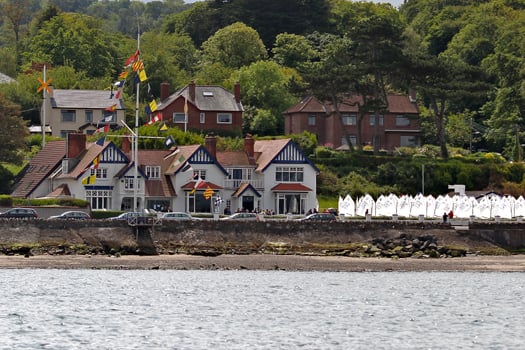
Royal North of Ireland Yacht Club and Optimist dinghies preparing to launch for an Ulster Championship race. Photo: Thomas Anderson
In 1902 several club members got together and commissioned the Fairy Class racing dayboat design. This Class has been sailed locally since then and although some of the boats migrated to Lough Erne the Class is still strongly supported at Cultra. Some of the boats have been substantially rebuilt in recent years. Club members have always been ready to accept new designs and in the 1930s the then new Dragon Class was adopted.
There was no club sailing during World War II but it was RNIYC members in the Dragon Class who represented Britain in the 1947 Olympic Games at Torbay. The 1970s saw the arrival of the Squib Class. The popularity of these boats has fluctuated over the years but, with thirty five boats, the Clubs fleet is now one of the largest in the British Isles.
Club racing for the Fairy, Squib and Mirror Classes and for other dinghies takes place on three occasions every week during the sailing season. Many Club members own cruising boats. Nowadays they keep them in local marinas or in Strangford Lough. Racing for the Cruisers used to include passage races organised jointly with the Clyde Cruising Club; however, these races are generally no longer popular and most cruiser racing currently is of the inshore variety. Nevertheless some of the Clubs boats can regularly been seen competing at Cork Week and in the Scottish series. Many of the Club's cruisers voyage far afield to foreign destinations whilst most enjoy the pleasure of taking their families to ports in N. Ireland and the nearby Scottish west coast and Isles.
The future of RNIYC lies in the hands of the extremely active and enthusiastic cadets who now number over one hundred.
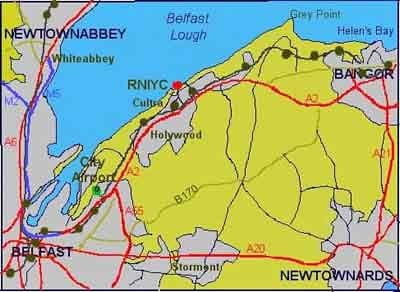 The Club is fortunate in its location. It lies between the two centres of greatest population density in Northern Ireland and good transport links from both abroad and locally make it easy for visiting competitors to reach the excellent sailing area. The Club has in recent years hosted the Edinburgh Cup, the Squib Nationals, Mirror Irish Nationals as well as other prestigious events. The racing is always keen while functions ashore are supported with suitable entertainment and excellent club catering to suit all tastes. The Club is constantly striving to improve facilities both on and off the water.
The Club is fortunate in its location. It lies between the two centres of greatest population density in Northern Ireland and good transport links from both abroad and locally make it easy for visiting competitors to reach the excellent sailing area. The Club has in recent years hosted the Edinburgh Cup, the Squib Nationals, Mirror Irish Nationals as well as other prestigious events. The racing is always keen while functions ashore are supported with suitable entertainment and excellent club catering to suit all tastes. The Club is constantly striving to improve facilities both on and off the water.
(Details and images courtesy of the Royal North of Ireland Yacht Club)
Royal North of Ireland Yacht Club, 7 Seafront Road, Cultra, Co Down BT18 0BB, N. Ireland. Office: 028 9042 8041 Bar: 028 9042 2257 Caterer: 028 9042 4352 Email: [email protected]
Have we got your club details? Click here to get involved




























